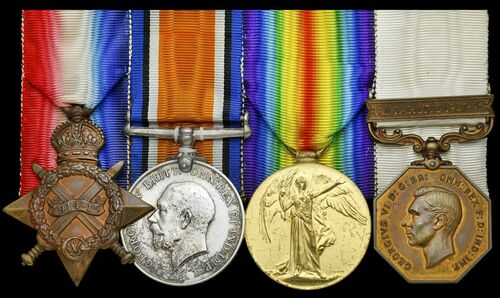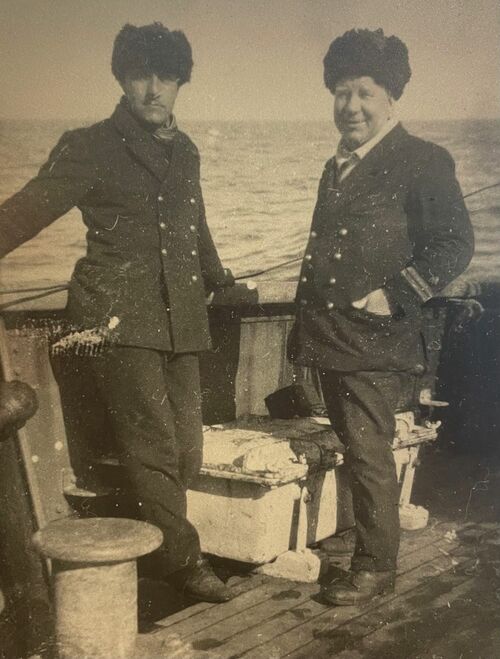Auction: 23002 - Orders, Decorations and Medals
Lot: 163
(x) The campaign group of four awarded to Engine Room Artificer G. S. Hunter, Royal Navy, who served three commissions in the Antarctic aboard the William Scoresby, the third as her Chief Engineer
1914-15 Star (M.1423 G. S. Hunter, E.R.A.4., R.N.); British War and Victory Medals (M.1423 G. S. Hunter. E.R.A.3 R.N.); Polar Medal 1904, G.VI.R., bronze issue, 1 clasp, Antarctic 1927-1935 (Gilbert Stuart Hunter), good very fine (4)
Provenance:
Wallis & Wallis, 1985.
A uniquely dated clasp to the Polar Medal.
Gilbert Stuart Hunter served as Second Engineer on the second and third commissions, and as Chief Engineer on the fourth commission of the Royal Research Ship William Scoresby. Born at Lewisham on 27 September 1893, he was an errand boy upon joining the Royal Navy from school on 9 November 1909. He signed-on to serve for 12 years from his eighteenth birthday. By the outbreak of the Great War Hunter was serving as an acting Engine Room Artificer 4th Class. He served aboard King George V and was present for the Battle of Jutland on 31 May 1916. In March 1917 he transferred to the destroyer Lysander and spent the rest of the War engaged in escort duties. Then he was described as 5' 7½" tall with black hair, grey eyes and a sallow complexion. Hunter was discharged from the Royal Navy on 5 January 1923, on reduction of the Service and just before his 12 year engagement was to conclude.
Appointed Second Engineer on the William Scoresby he served on the second, third and fourth commissions. The William Scoresby was a tiny vessel of 125ft long at the water line and with a 26ft beam. Her main job was whale marking. Darts were fired from hand-held sporting rifles. In addition she completed a quantity of oceanographical work collecting information about the distribution of plankton and krill. Much of this work was carried out along the edge of the Antarctic pack ice.
The second commission (December 1927-June 1930) was an oceanographical cruise between the Falkland Islands, South Georgia and the South Shetland Island. Where ever possible daily plankton trawls were taken though bad weather frequently interrupted this. In 1929 the William Scoresby was assigned to act as a base for Sir Hubert Wilkins' second season of flights over Antarctica. Flights to Charcot Island and over the Weddell Sea were supported. The William Scoresby returned to London on 15 June 1930.
Her third commission left London on 29 October 1930. This was an oceanographical and whale marking cruise round South Georgia and the northern part of the Weddell Sea. During the austral winter she carried out a survey of the coastal current off Peru, and a trawling survey of Burdwood Bank. Hunter was promoted Chief Engineer at the end of this voyage. Back home he married Annie M. Fleming.
On the fourth commission, Hunter was the Chief Engineer. The William Scoresby left Simonstown on 26 November 1934 on a whale marking cruise to the pelagic whaling grounds south of South Africa. This cruise was again interrupted by bad weather.
On 7 October 1941, the London Gazette announced the awards of bronze Medals to selected members of the Discovery Investigations. In all 97 recipients were decorated. Ninety-three men received G.VI.R. bronze Medals with dated clasps and four men who had previously received bronze Medals added a clasp (Engineering Lieutenant Commander William Ault Horton was incorrectly awarded a bronze clasp for his silver Medal). Hunter received the bronze Polar Medal with the unique clasp 'Antarctic 1927-35' which was sent to him after the Second World War.
After his service Hunter was employed as an Engineer with the Elham Light Railway in Kent and he died at Inwood Cottage Hospital, Alton, on 1 April 1952.
Subject to 5% tax on Hammer Price in addition to 20% VAT on Buyer’s Premium.
Sold for
£8,000
Starting price
£2500









